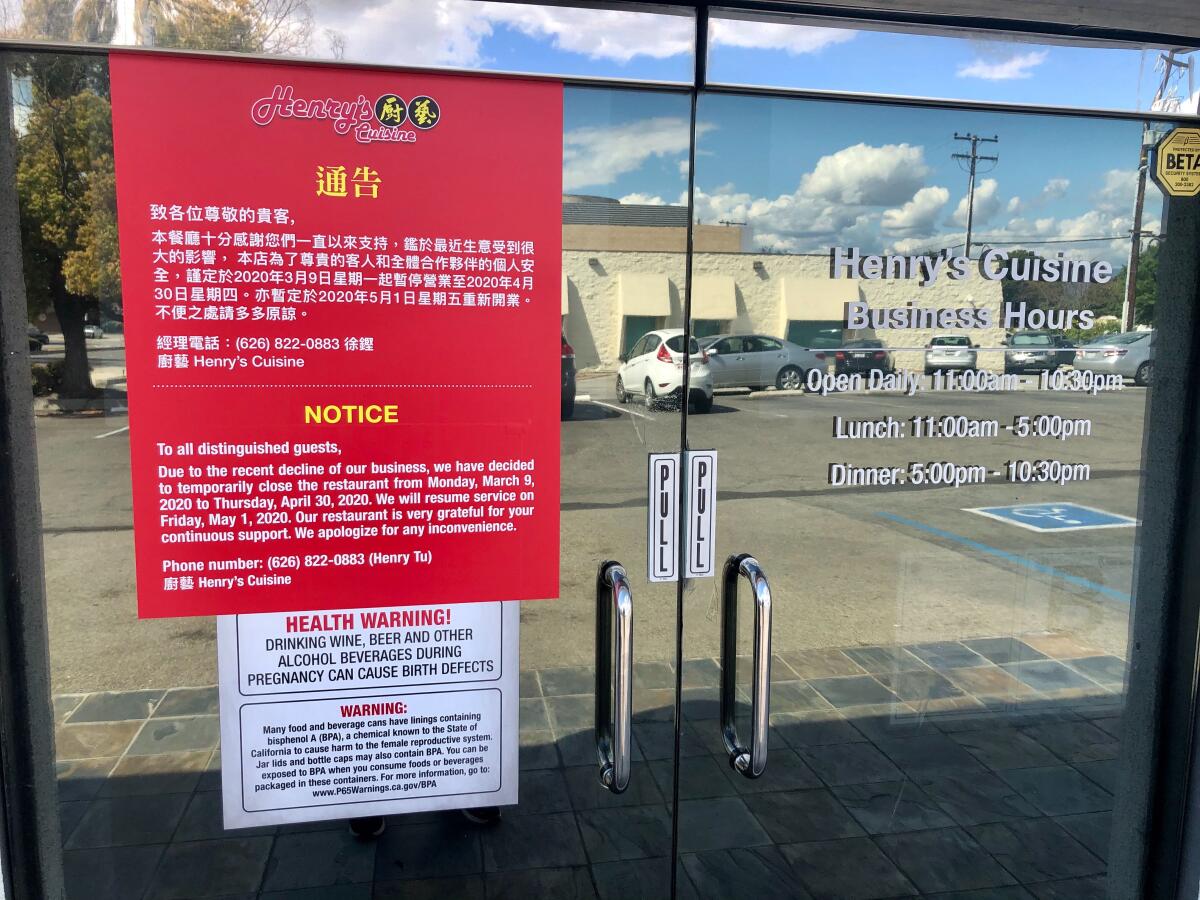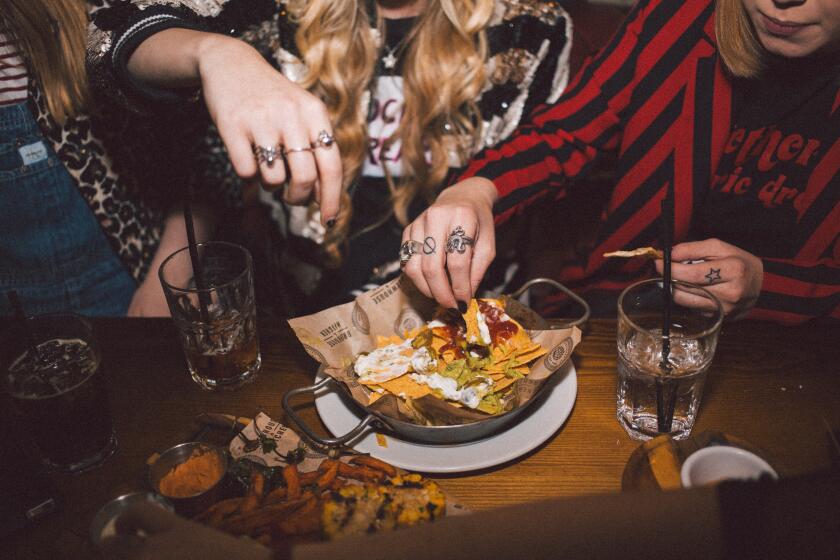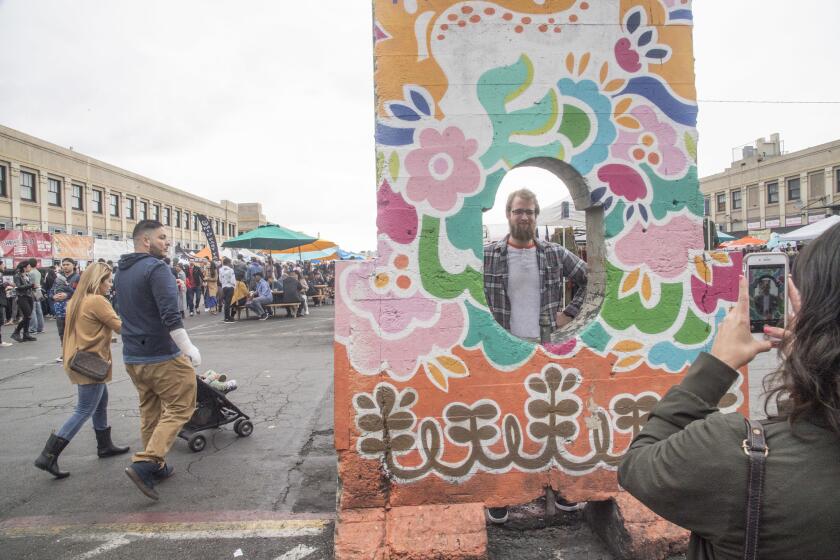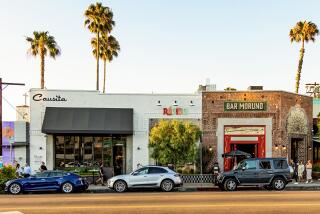Coronavirus outbreak has some Los Angeles restaurants taking drastic measures

No drink refills or cash payment, more spacing between diners, thermometers at the front door: To contend with the rapid spread of novel coronavirus, restaurant owners and chefs in Los Angeles are adopting strict measures to prevent the spread of germs â and to keep business running as normally as possible.
âWe are taking things seriouslyâ at Alimento in Silver Lake and Cosa Buona in Echo Park, owner Zach Pollack said in an Instagram post. âWeâve removed tables to increase space between guests, invested in the worldâs last bottles of Lysol to disinfect server stations throughout the shift, and have changed the way we handle cash and table settings.â
Similar sentiments were shared on social media by restaurants including Luv2eat Thai Bistro, Hail Mary, Joanâs on Third, La Morra, Monkfish Brewing, Little Flower, Go Get âEm Tiger, Burgers Never Say Die, Jon & Vinnyâs, Badmaash, Lasa and Wax Paper.
What exactly should we think when it comes to questions of eating and the novel coronavirus panic and pandemic?
Other restaurants are taking more drastic measures. On Wednesday morning, the manager of Henryâs Cuisine in Alhambra stood in the restaurantâs parking lot informing customers that the Hong Kong-style cafe would be closed until May 1. A sign on the window nearby thanked customers for their support and apologized for any inconvenience.
Business at the 5-year-old Cantonese restaurant had plummeted in the last few weeks, largely due to concerns over the spread of novel coronavirus, said the manager, who declined to give his name because he wasnât authorized to speak on the restaurantâs behalf. A breakfast destination popular among older Cantonese diners, Henryâs is one of the most prominent restaurant casualties amid a widespread drop-off in business at Chinese restaurants in the San Gabriel Valley and beyond.
Since late January, Sichuan Impression has used infrared thermometers to screen patrons for fever at its three locations in Alhambra, Tustin and West Los Angeles. Those who refuse to have their temperature checked are declined service.
The announcement that the the weekly DTLA food festival would be put on hiatus came after California Gov. Gavin Newsom urged residents to cancel public gatherings of 250 or more people.
Restaurants of all kinds, in neighborhoods across Los Angeles, have reported a decline in business in the last several weeks. Several chefs said their reservations had dropped to just a handful of bookings a night; others noted business had dropped by half.
Diners are faced with a tough choice during the pandemic: wanting to continue supporting their favorite places while mulling over advice from officials telling them to stay home.
On a Wednesday night in Silver Lake, the perma-nightclub environment of Night + Market Song was ratcheted down from an 11 to about an 8. There were a couple of empty tables â usually there is none. The people waiting to be seated, glasses of natural wine in hand, were gregarious and shouting over the music as usual, but didnât spill out onto the sidewalk as they sometimes do.
âYouâve got to live your life,â said diner Jess Best, 27. âThe only thing you have control over is how you feel. If we all stay home, everyoneâs kind of suffering. No one makes money.â
Up Sunset Boulevard at Vivian Kuâs Pine & Crane, there was a similar feel: a relatively young crowd enjoying an evening out. As at Night + Market, it was busy but not overly so: There was an empty two-top by the large picture window, but the big communal table in the middle of the dining room was filled with people passing plates of pork buns and bamboo shoots.
Laura Kawashiri, 25, said she wasnât planning to change her dining-out habits but was at least marginally concerned with the latest coronavirus developments. She thought a lot about finger food, for example, and how it brought her hands close to her mouth â something that people have been repeatedly told to avoid.
But overall, it wasnât enough to keep her home. âIâll continue to do the things Iâm doing,â said Kawashiri, who works at a startup in Torrance.
Outside the restaurant on a bench, however, Joey Falsetta, 47, was waiting for a to-go order. Heâd originally meant to dine in, then changed his mind. âIâm sitting here right now,â he said, gesturing to the bench, âand thereâs two seats right there.â He pointed toward the restaurantâs window to an empty table and shrugged.
Owners also face a delicate balance between wanting to keep revenue healthy while maintaining safe restaurant conditions for workers and diners. Some are encouraging people to stay at home if theyâre sick.
âIf you do come out, make sure you are being responsible for the well-being of others and yourself,â Josef Centeno, chef of restaurants including Bäco Mercat and Orsa & Winston, said in an Instagram post on Thursday. âCoughing and sneezing all over the dining room is not cool. This is not panic, itâs common sense.â
He added, âI am not forcing employees to work and making it at-will.â
For many restaurant workers, staying home isnât always an option. Paid sick leave for California employees is limited to three days per year and many low-wage earners in the industry have limited access to health insurance and canât afford to miss work for extended periods of time.
Steve Grandjean, the owner of Gourmet Imports, a food distributor that supplies many upscale restaurants in L.A. including Trois Mec and Providence, said that he had spoken with several owners facing dire reductions in bookings over the last few days, particularly those where the clientele were relatively older.
âI heard from a restaurant in the [San Fernando] Valley that had seen business fall by 50% almost overnight,â he said. âBut there are also restaurants that maybe attract a younger audience who donât seem to have been as affected. Itâs difficult to get a sense of what is happening across the board, but I donât think itâs a positive situation for anyone.â
At Yangâs Kitchen, a beef noodle shop in downtown Alhambra, dine-in business has been down in the last week, but that takeout orders had risen slightly.
âItâs been slow, but weâre hoping delivery will pick up,â owner Chris Yang said. âAt some point people have to start eating at restaurants again, right?â
Broader issues loomed after a Wednesday press conference by the L.A. County Health Department in which officials recommended that high-risk groups, including those who are pregnant, elderly or have underlying health issues, should âavoid non-essential travel, public gatherings or places where large groups of people congregate.â
The agency did not specify what constitutes a large group, but in a separate statement, Gov. Gavin Newsom said gatherings of 250 or more people should be canceled.
According to Grandjean, the most pressing concern at the moment among restaurants heâd spoken with was a sudden increase in reservation cancellations â many of which came without notice â which complicated how businesses were able to prepare for the slowdown.
âL.A. has always been bad about no-shows, but recently itâs reached another level,â he said, adding that he had spoken with the chef of a busy Venice restaurant who had seen large group reservations plummet, with many diners forfeiting nonrefundable deposits.
Lisa Geffen, chef-partner of Audrey at the Hammer Museum, said the cancellation of classes at UCLA along with most of the museumâs public programming has led to a â50% to 60% reduction in businessâ at her modern California bistro.
âIt changes day by day, but right now weâre not expecting a return to normalcy until UCLA is back in session, at the earliest,â Geffen said.
She added the restaurant would begin taking steps it normally would during prolonged slow periods: reducing business hours, temporarily dropping some menu items, and emphasizing delivery and takeout options, all of which would be implemented in ways that âdisrupt the lives of employees and customers as little as possible.â
Geffen echoed the feelings of many local chefs and restaurant owners.
âWe want people to come eat and dine out still, but if there are certain restrictions from the city, we also donât want to force people to take risks theyâre not comfortable with,â she said.
âRight now, itâs a waiting game. And when you have a restaurant that runs on thin margins, which is all restaurants basically, the waiting game can be scary.â
More to Read
Eat your way across L.A.
Get our weekly Tasting Notes newsletter for reviews, news and more.
You may occasionally receive promotional content from the Los Angeles Times.













